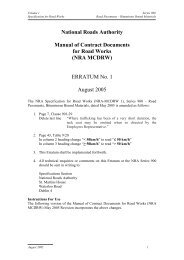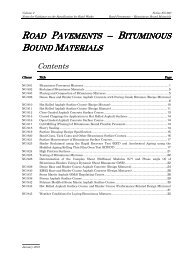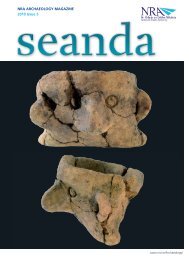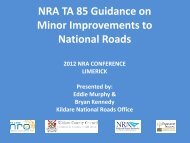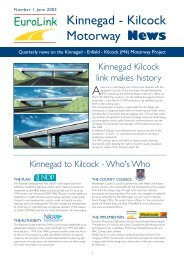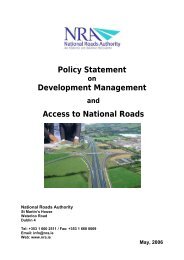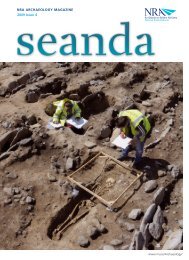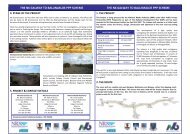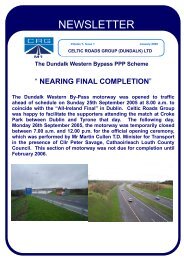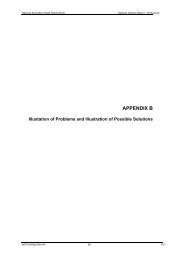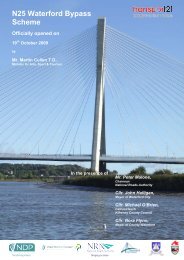Guidelines for the Treatment of Badgers Prior to - National Roads ...
Guidelines for the Treatment of Badgers Prior to - National Roads ...
Guidelines for the Treatment of Badgers Prior to - National Roads ...
Create successful ePaper yourself
Turn your PDF publications into a flip-book with our unique Google optimized e-Paper software.
2<br />
GUIDELINES FOR THE TREATMENT OF BADGERS<br />
PRIOR TO THE CONSTRUCTION OF NATIONAL ROAD SCHEMES<br />
IMPACT OF ROAD SCHEMES<br />
New road infrastructure may directly or indirectly impact<br />
on badgers. Construction may result in death or injury <strong>to</strong><br />
badgers within setts, as well as <strong>the</strong> destruction <strong>of</strong> setts, loss<br />
<strong>of</strong> <strong>for</strong>aging habitat or dissection <strong>of</strong> <strong>the</strong>ir <strong>for</strong>aging areas.<br />
Construction works close <strong>to</strong> breeding setts can cause<br />
serious disturbance <strong>to</strong> badgers and mortality <strong>of</strong> cubs.<br />
Where loss <strong>of</strong> habitat is likely <strong>to</strong> be greater than 25%,<br />
<strong>the</strong> impact may be considered as significant on <strong>the</strong> affected<br />
social group. <strong>Badgers</strong> may be killed or injured by road<br />
traffic as <strong>the</strong>y attempt <strong>to</strong> access <strong>the</strong>ir feeding areas. This<br />
can significantly affect <strong>the</strong> viability <strong>of</strong> badger groups in an<br />
area. They may also pose a road safety issue <strong>for</strong> mo<strong>to</strong>rists<br />
as badgers attempt <strong>to</strong> cross roads <strong>to</strong> and from <strong>for</strong>aging areas.<br />
Where loss <strong>of</strong> habitat<br />
is likely <strong>to</strong> be greater<br />
than 25%, <strong>the</strong> impact<br />
may be considered as<br />
significant on <strong>the</strong><br />
affected social group.<br />
<strong>Badgers</strong> are commonly found in woodland areas.<br />
© George McCarthy/naturepl.com<br />
<strong>Badgers</strong> and <strong>the</strong>ir setts are protected under <strong>the</strong> provisions<br />
<strong>of</strong> <strong>the</strong> Wildlife Act, 1976, and <strong>the</strong> Wildlife Amendment<br />
Act, 2000. It is an <strong>of</strong>fence <strong>to</strong> intentionally kill or injure a<br />
protected species or <strong>to</strong> wilfully interfere with or destroy<br />
<strong>the</strong> breeding site or resting place <strong>of</strong> a protected<br />
wild animal. It is standard best practice <strong>to</strong> ensure that<br />
mitigation measures are taken <strong>to</strong> limit impacts on badgers<br />
and badger populations and <strong>to</strong> contribute <strong>to</strong> safety by<br />
reducing collisions between badgers and vehicles. On road<br />
schemes, such measures might include removal <strong>of</strong> badgers<br />
from affected setts, provision <strong>of</strong> badger-resistant fencing<br />
and wildlife underpasses (that allow badgers access <strong>to</strong> <strong>the</strong>ir<br />
<strong>for</strong>aging areas). Where significant badger setts have <strong>to</strong> be<br />
removed, alternative artificial setts may need <strong>to</strong> be created.<br />
The removal <strong>of</strong> badgers from affected setts and subsequent<br />
destruction <strong>of</strong> <strong>the</strong>se setts must be conducted under licence<br />
by experienced badger experts or o<strong>the</strong>r suitably qualified<br />
personnel. The <strong>National</strong> Parks and Wildlife Service<br />
GUIDELINES FOR THE TREATMENT OF BADGERS<br />
PRIOR TO THE CONSTRUCTION OF NATIONAL ROAD SCHEMES<br />
LEGISLATION FOR THE PROTECTION OF BADGERS<br />
Sett excavation revealed <strong>the</strong> underground tunnel system <strong>of</strong> a sizeable main sett<br />
located next <strong>to</strong> a stream. The sett had 18 entrances, 17 chambers, and was<br />
24m across. Total tunnel length approximately 132m.<br />
(NPWS) <strong>of</strong> <strong>the</strong> Department <strong>of</strong> <strong>the</strong> Environment, Heritage<br />
and Local Government grant licences <strong>to</strong> <strong>the</strong> experts<br />
undertaking <strong>the</strong> badger operations and not <strong>to</strong> <strong>the</strong><br />
developer or contrac<strong>to</strong>r. An application <strong>for</strong> a wildlife licence<br />
should be submitted <strong>to</strong> <strong>the</strong> NPWS with <strong>the</strong> relevant<br />
ecological in<strong>for</strong>mation from <strong>the</strong> detailed badger survey. At<br />
least three weeks is normally required <strong>to</strong> process a licence<br />
application, but early discussions with NPWS can expedite<br />
<strong>the</strong> procedure.<br />
Conditions are usually attached <strong>to</strong> each wildlife licence<br />
granted in respect <strong>of</strong> badgers. It is normal practice <strong>to</strong><br />
impose seasonal constraints e.g. that breeding setts are not<br />
interfered with or disturbed during <strong>the</strong> badger breeding<br />
season (December <strong>to</strong> June inclusive).<br />
3<br />
No active sett should be interfered with or disturbed<br />
during <strong>the</strong> breeding season as any sett category may<br />
contain cubs. Closure <strong>of</strong> setts during <strong>the</strong> breeding season<br />
would require moni<strong>to</strong>ring <strong>to</strong> demonstrate no sett activity.<br />
It is an <strong>of</strong>fence <strong>to</strong><br />
intentionally kill or injure<br />
a protected species or <strong>to</strong><br />
wilfully interfere with or<br />
destroy <strong>the</strong> breeding site<br />
or resting place <strong>of</strong> a<br />
protected wild animal.






